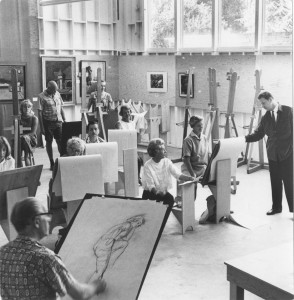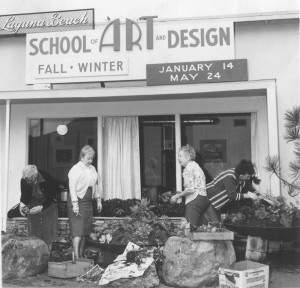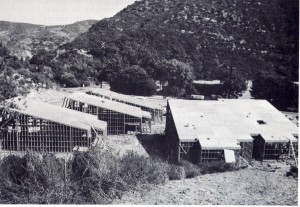
The Laguna College of Art and Design celebrates its 50th birthday on Thursday, Sept. 15, with a reception and faculty exhibition at Seven Degrees and the fanfare befitting a half-century milestone.
LCAD, as it’s known today, was founded as the Laguna Beach School of Art in 1961 by members of the Festival of Arts and the Laguna Beach Art Association, artists and supporters intent on providing the Laguna community with art education.
By now, the institution has grown into a nationally accredited and internationally respected art school with an enrollment of roughly 450, including both undergraduate and graduate students.
Fifty years have brought changes that keep reflecting the times: At first there were free spirits like a young faculty committed to teaching representational art and, in doing so giving a middle-digit to pundits that disdained depiction of anything that was recognizable and so-called artists who found “liberation” by refusing to learn how to draw.
It did not take those mavericks like LCAD’s current president Jonathan Burke long to find out that they were not alone, that there were students who wanted to emulate old masters rather than just “saying something.”
Shaping the school’s character were past presidents who include Ruth Osgood-Salyer, 1961-’74; David Patterson, 1974-’76; Lewis Cohen, 1976; Richard Tobin, 1977; Patricia Caldwell, 1984-’86; J.Thomas Reeves, 1987; William Otton, 1988; Russel E. Lewis, 1990; John Lottes, 1991; Oscar Frenzel, 1996; Alan Barkley, 1997; Hél`ene Garrison, 2004; and Dennis Power who took the helm in 2005 and retired this year.

Multi-media artist and LCAD trustee emerita Anne England remembers those heady early days well. “In 1964, I was a scholarship student and took painting classes from Roger Kuntz and Roger Armstrong, and print making from Paul Darrow,” she recalls. “We were young and crazy, enough for a teacher to often ask us whether we had smoked funny cigarettes.” (They did, according to England.)
“The faculty were the giants at the time and they were the most committed mentors. I learned more in those four years than I did in graduate school,” she said.
LCAD shaped its master of fine art program during England’s board tenure and she also helped revamp the annual Collector’s Choice auction while on its funding committee.
Even early on, Burke noted that students were not as freewheeling as others because the curriculum was always strict. “We secured our reputation by the skills and talent of our alumni,” he said.
He began teaching at the school in 1980, by then moved to its bucolic canyon campus and in the process of seeking the imprimatur of established academia. The campus earned accreditation by the Western Association of Schools and Colleges and National Association of Schools of Art and Design.
“At 29, I was not much older than the students but had looked for a school with a representative tradition,” Burke said. As he rose from part timer to fine arts dean, he became instrumental in shaping a curriculum that, in his words, gives students solid technical choices but also permits their own creative choices. Thus, while students elsewhere tinkered with concepts and found objects, those enrolled in what was then called the Laguna Art Institute concentrated on figurative drawing and painting, anatomy and enough chemistry to know their mediums intimately.

Garrison, who served as president for a year and is now dean of liberal arts and academic affairs vice president, came on board in 1984, choosing a part-time slot teaching art history over full time ones elsewhere. “My space was small, six to nine students crammed into what’s now the president’s office, but I was attracted to the atmosphere. It felt very artistic,” she recalled. Since then, she said, the student body keeps growing steadily and change appears gradual, even if campus facilities sprawl across four locations.
After tentatively exploring a satellite location in Irvine earlier this year, administrators are currently exploring how to consolidate and plan for future growth by increasing density at their main campus.
Besides majors in painting, drawing and illustration, students can now chose animation, graphic design (with a new program in action sports design) and game art. A new major in sculpture has been added along with career advice and placement services.
Today, even students majoring in traditional painting bring a modern twist to their studies and future vocation, said John Eagle, a locally renowned plein-air painter who initially embraced his calling reluctantly. “Our instructor forced us to go paint outside and I fell in love,” he said. Like several former students, he also became an instructor. “I was invited because no one taught plein-air in the ‘90s,” he said. The genre is undergoing a popular resurgence with a modern twist, he said. “Students now aim for something dramatic in their approach to painting. They don’t care what constitutes museum quality; none of this painting in thin, careful layers. That sort of art is for dinosaurs,” he said.
LCAD library director Jennifer Martinez Wormser is busy compiling the college’s archives and is asking the community to rifle through closets and drawers for papers pertaining to the college that former students may have squirreled away. “It’s critical for us since so much material was lost when the administration building burned in 1979. Material that provides links to the college would be useful, old catalogues, journals, anything,” she said.
Burke offered his take on the next 50 years: “We will always maintain our presence in Laguna Beach. The campus will become denser with most buildings growing to two stories, at least. There will be more amenities for students and more connection to the community and our reputation expanding internationally.”
He anticipates more majors and disciplinary hybrids and more international student and faculty exchange programs, adding to an already increasingly diverse student body and faculty.
For now, given its disciplinary crossover potential, illustration is the college’s most popular major, true at art schools across the country.
And, though the college’s president professes cloudiness in his crystal ball, he promised LCAD’s illustrators would continue to embellish a work in progress.




